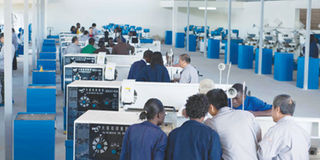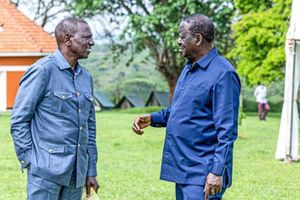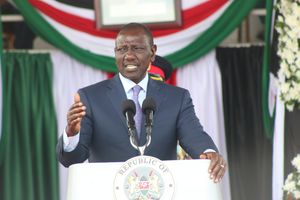Colleges facelift shifts focus to technical skills

PHOTO | MARGARETTA WA GACHERU Trainers from China demonstrate the use of machines imported from their country at the Technical University of Kenya, formerly the Kenya Polytechic, Nairobi.
What you need to know:
- A whole slew of new vocational training institutes are being established through an agreement signed by the governments of Kenya and China
In the past few months, President Mwai Kibaki has launched 15 new public universities, all with a view to achieving the goal set in Vision 2030. Yet the fact that all the 15 came into being as a result of upgrading colleges and polytechnics has generated mixed feelings among a number of educationists and education-loving Kenyans.
Some have questioned the wisdom of such a rapid shift at the institutional level. They wonder whether there will be sufficient faculty to teach these new burgeoning learning institutions. But numbers are not the only issue being raised. Will the quality of education be diluted, now that the focus seems to be more on quantity than quality?
The other question being asked relates not so much to quality as to the learning experience. Do Kenyans need more academic learning, which is what universities normally offer, or does the country need more technically qualified youth equipped with practical skills — the sort that were previously being taught at the polytechnics and colleges that are now part of the university system?
Some critics will say that question is a no-brainer since universities tend to turn out prospective white collar workers, while Kenya’s more urgent need is a technically-skilled workforce equipped to start up their own small businesses.
Fortunately, the Ministry of Higher Education has not forgotten about vocational training for Kenyans despite the obsession with expansion of the university system. A whole slew of new vocational training institutes are being established through an agreement signed by the governments of Kenya and China to upgrade rural youth polytechnics to the rank of technical training institutes (TTI).
From Bungoma, Kakamega, and Kisii to Meru, Machakos, Muranga, and the Rift Valley, the Kenya-China Technical Vocational Education Training programme (TVET) has been equipping rural polytechnics with machines and trainers contracted through the Chinese firm, Avic International — the same engineering company that is constructing the new Terminal Four at Jomo Kenyatta International Airport in Nairobi and supplying fire-fighting equipment to the National Youth Service.
“So far, we’ve been helping the ministry to establish 10 new technical training centres all across Kenya,” says Qi Lin, the project manager, who has just completed the first phase of training Kenyan instructors in operating machinery brought in from China.
The trainee instructors came from 10 technical training institutes, nine of which were recently upgraded from youth polytechnics. They include Bushangala TTI and Shamberere TTI in Kakamega County, Kisiwa TTI and Matili TTI in Bungoma County, Wote TTI in Machakos, Kirua TTI in Meru, Keroka TTI in Kisii, Murang’a TTI, and Rift Valley Institute of Science and Technology in Nakuru.
“Once we have installed all the machines and trained the Kenyan instructors, we’ll move on to Phase Two of the project, where we will conduct similar installation and training in 40 new vocational training institutes,” adds Lin, who has been in Kenya since 2010, overseeing the $20 million (about Sh1.7 billion) project.
Having hit the ground running since arrival, Lin has clocked thousands of kilometres travelling by road to vet and select 10 local polytechnics (out of the 20 suggested by the Ministry of Higher Education) and 24 best qualified instructors in the fields of mechanical and electrical engineering to benefit from the project. The instructors are trained both in China and Kenya on how to operate the new machines.
It is a major technology transfer project and the 28-year-old aeronautical engineer has overseen the importation and installation of 153 container-loads of three different types of machines meant not only for the training of qualified Kenyan technicians, but also to upgrade Kenya’s manufacturing sector.
A portion of the machines have already filled electrical and electronic labs. Others are still being installed in mechanical engineering departments with the support of Avic’s installation team. The remainder, called “advanced rapid prototyping” machines, will allow Kenyan technicians to reproduce anything from spare parts and soda bottles to jaw bones and original works of art.
The one university where all the three sets of machines have been installed is the former Kenya Polytechnic University College, renamed Technical University of Kenya after it was granted a university charter in January.
The former Kenya Polytechnic is also where the 24 Kenyan instructors that Lin hand-picked just completed their one-month refresher course in operating the machines.
Having spent four months in China in 2011 at two of the best technical training colleges in the country, the 24 instructors will in future be responsible for teaching young Kenyans to operate the machines.
In China, experienced Kenyan teachers like Emmanuel Okech, who has taught mechanical engineering for 16 years at Bushangala Youth Polytechnic, studied rapid prototyping at Xi’an Jiaotong University’s National Engineering Research Centre of Rapid Manufacturing with Dr ‘Jim’ Chi Jinchun.
Dr Chi is one of the 19 Chinese instructors who taught the Kenyan engineers like Okech, David Maru, and Mary Nabang’ala, then followed them back to Kenya to continue their training to ensure that they mastered the machines on their own home turf.
Other Kenyan instructors like Kennedy Natoka, who teaches at the Kisiwa Technical Training Institute, studied at the Inner Mongolia Technical College of Mechanical and Electrical Engineering, an award-winning school which, according to Lin, is one of the best vocational training centres in China.
“We selected eight Kenyan instructors in each of the three engineering fields to train in China,” said Lin, who feels strongly that the success of the TVET project will be measured by how well Kenyans themselves are able to operate the machines in the future.
“That is why we place so much emphasis on practical training. We have seen other countries bring machinery to Kenya, but it rarely gets put to good use because the donor countries simply sell the machines but don’t bother to train locals in their usage,” adds Lin.
Some of the Chinese trainers do not speak English or Kiswahili. “But they know the ‘universal language of science’ and they work closely with me,” says Li Man Liang. An electrical engineer, Li served as an interpreter/translator throughout the training of Kenyans to ensure that the teaching was clear.
Acknowledging that the machinery is a major investment, Lin says he hopes that the Kenyans who learn to operate the machines will involve the private sector to expand local manufacturing in many fields.
Noting that the machines can manufacture everything from conveyer belts and traffic lights to spare parts of all types, Lin says the possibilities are limitless. “People wonder how the Chinese economy has grown so fast. Well, it’s largely because we are focusing on training skilled workers in various fields of manufacturing. That’s how we became the manufacturing capital of the world.
Kenya will have a similar capacity to do the same for all of Africa if they utilise these machines well and link up local technicians with private sector manufacturers. I’d love to see that happen and I’m happy to assist.”




